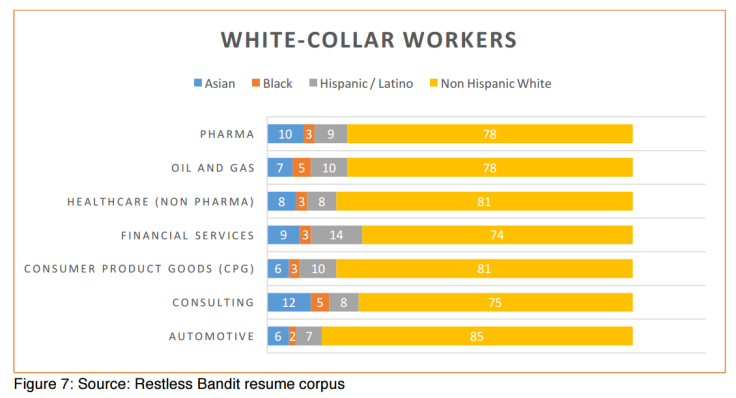Racism In US Job Market: Blacks, Hispanics Underrepresented In White Collar Jobs, Tech Industry Leads

The disparity in corporate diversity in white-collar jobs across various industries in the United States is not unheard of. If a recent report released Wednesday by Restless Bandit, a San Francisco-based HR tech company, is anything to go by, the “diversity gap” in white-collar jobs showcases overwhelming deficits.
According to the report, black people make up only 2-3 percent of the white-collar workforce — significantly less than their total workforce participation rate of 12 percent. Only about 5 percent of Hispanic workforce contributes to white-collar jobs. This is at odds with today’s population distribution. According to the 2010 United States Census, there were over 38 million black and African-Americans in the United States, representing 12.4 percent of the population. In addition, there were 42 million non-Hispanic black, which comprised 12.1 percent of the population.

However, as the report suggests, companies across the country are finding that in order to be successful, employee diversity should demographically mirror the population and their customers. In the report, Restless Bandit founder and CEO Steve Goodman and his data science team determine exactly how much each sector would need to increase their minority workforce in order to eliminate deficits.
The tech industry is the biggest laggard in hiring black minorities for white-collar jobs in the U.S. Data released in the same report suggests that there is a massive 643 percent deficit of black people in white-collar jobs compared to the black population as a whole. Hispanics are also unrepresented by 500 percent in white-collar jobs compared to their representation of the total workforce.

The report highlights that the automotive industry is also lagging in white-collar hiring of black people and Hispanics. In order to bridge the diversity gap, the industry would need to increase hiring of these groups by 420 percent and 239 percent respectively.
While black people in white-collar financial service are underrepresented by 550 percent diversity gap, nonpharma healthcare white-collar jobs are also underrepresented by minorities with an over 275 percent diversity gap.
The report, however, points out that despite the disparity, the demographic composition of the United States is rapidly changing. Highlighting reports from the Census Board, it states that non-Hispanic whites will be a minority, representing 46 percent of the U.S. population by 2050. Population increases will mostly be in the Hispanic and Asian populations, gaining 13 percent and 4 percent, respectively.

It also sees a steady growth in the non-white labor pool across the country and forecasts that they will be a majority by 2050.
© Copyright IBTimes 2025. All rights reserved.





















